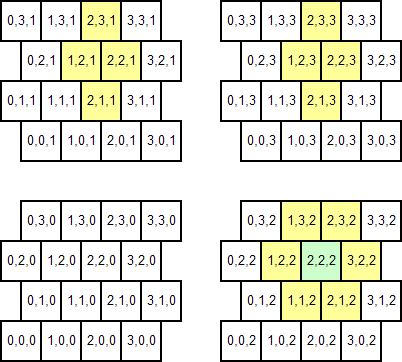Greetings,
I'm working on a game project that uses a 3D variant of hexagonal tile maps. Tiles are actually cubes, not hexes, but are laid out just like hexes (because a square can be turned to a cube to extrapolate from 2D to 3D, but there is no 3D version of a hex). Rather than a verbose description, here goes an example of a 4x4x4 map:

(I have highlighted an arbitrary tile (green) and its adjacent tiles (yellow) to help describe how the whole thing is supposed to work; but the adjacency functions are not the issue, that's already solved.)
I have a struct type to represent tiles, and maps are represented as a 3D array of tiles (wrapped in a Map class to add some utility methods, but that's not very relevant).
Each tile is supposed to represent a perfectly cubic space, and they are all exactly the same size. Also, the offset between adjacent "rows" is exactly half the size of a tile.
That's enough context; my question is:
Given the coordinates of two points A and B, how can I generate a list of the tiles (or, rather, their coordinates) that a straight line between A and B would cross?
That would later be used for a variety of purposes, such as determining Line-of-sight, charge path legality, and so on.
BTW, this may be useful: my maps use the (0,0,0) as a reference position. The 'jagging' of the map can be defined as offsetting each tile ((y+z) mod 2) * tileSize/2.0 to the right from the position it'd have on a "sane" cartesian system. For the non-jagged rows, that yields 0; for rows where (y+z) mod 2 is 1, it yields 0.5 tiles.
I'm working on C#4 targeting the .Net Framework 4.0; but I don't really need specific code, just the algorithm to solve the weird geometric/mathematical problem. I have been trying for several days to solve this at no avail; and trying to draw the whole thing on paper to "visualize" it didn't help either :( .
Thanks in advance for any answer